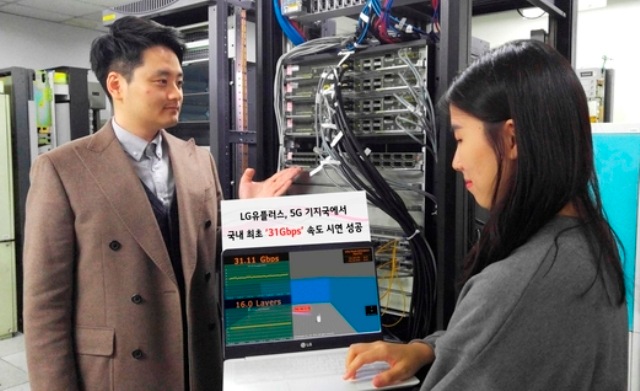Huawei Joins Hands with LG U+ to Complete 5G Full-Scenario Test
31 Gbps Peak Rate, 0.5ms Delay, and mMTC Massive Connections per Cell
[Seoul, Korea, November 30, 2016] Huawei and LG U+ (a leading telecom operator in Korea) have announced the completion of a series of joint tests based on three 5G commercial scenarios: enhanced mobile broadband (eMBB), uRLLC, and mMTC. According to the test results, the cell peak rate reached 31 Gbps, latency was less than 0.5 ms, and mMTC single-cell massive connections. These facts imply that the two partners have verified and studied live 5G technical performances during the test, which is a great step forward for 5G commercial deployment.

Since new immersive services such as virtual reality (VR) and augmented reality (AR) are steadily maturing, future wireless networks are required to provide Gbps transmission rates. Operators can obtain more continuous spectrum resources on millimeter waves than on low frequency bands, which provide large network capacity and excellent user experience in densely populated urban areas. In these joint testing phases, spectral efficiency demonstrated a noticeable improvement with cell peak rate reaching 31 Gbps supported on high-frequency bandwidth and Massive MIMO.
5G must enable eMBB services that require ultra-large broadband and the uLLC and mMTC services for applications such as smart driving and Internet of Things (IoT) to satisfy diverse service requirements. During the test procedures, Huawei and LG U+ verified key technologies of 5G New Radio. Simultaneously using the short TTI and f-OFDM, latency was reduced to 0.5 ms. An adoption of Sparse Code Multiple Access (SCMA) allows for a significant increase in the number of cell connections for mMTC.
LG U+, as a leading LTE operator in Korea is eager to realize the rapid deployment and introduction of 5G technologies on LTE networks. The operator and Huawei will perform further tests of LTE and 5G Dual Connectivity based on the CloudRAN architecture. The cloudified RAN architecture achieves control and bearer decoupling. Existing LTE networks are used to bear control-plane data, ensuring the continuity and consistency of user experience. And user-plane data is distributed through LTE and 5G networks, improving user rate and experience.
Kang Jung Ho, Vice President of LG U+, said, "LG U+ is dedicated to creating new better life for our customers through maximized value and improved experience. We hope to provide the availability of 5G services for Korean users by 2018, and Huawei's innovation insights and accumulated expertise will help us in achieving this goal."
Gan Bin, Vice President of Huawei Wireless Network, remarked, "Huawei boasts rich knowledge and experience in the field of 5G high- frequency, especially with continuous innovation and solid investment. In the near future, we will strengthen the cooperation and partnership with LG U+ and keep innovating to bring 5G into reality."
Since the signature of a 5G memorandum of understanding (MoU), Huawei and LG U+ have worked closely together to prepare for the pre-commercial use of 5G by 2018. These combined planning efforts can be seen in the series of field tests which help represent an important milestone for future 5G commercial deployment.

